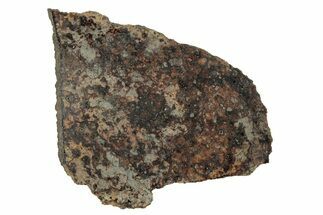This Specimen has been sold.
.66" Chondrite Meteorite Fragment (1.5 g) - NWA 7963
This is a .66" wide (1.5 gram) fragment of the chondrite meteorite NWA 7963 displaying some gorgeous pyroxenes.
NWA 7963 is the name given to an LL5 chondrite found in the western Sahara sometime in 2013. The find consists of a single stone weighing about 460 grams, and was purchased in Agadir, Morocco from a meteorite prospector.
Fusion crust covers about 65 percent of the total mass, and its exterior surfaces contain a few regmaglypts. The interior displays brecciated textures with indistinct chondrules, plagioclase, apatite, and grains of nickel-iron and iron sulfides.
Fusion crust covers about 65 percent of the total mass, and its exterior surfaces contain a few regmaglypts. The interior displays brecciated textures with indistinct chondrules, plagioclase, apatite, and grains of nickel-iron and iron sulfides.
About L6 Chondrite Meteorites
An L6 chondrite meteorite is a type of stony meteorite belonging to the ordinary chondrite group, the most common category of meteorites found on Earth. The "L" designation indicates that it has a relatively low total iron content, typically about 7-11%, with iron present in the form of metal grains and sulfides. The "6" refers to its petrologic type, which signifies the extent of thermal metamorphism it has undergone. As a type 6 meteorite, an L6 chondrite has been extensively heated, resulting in the complete recrystallization of its original components. This process has homogenized its mineral grains and largely obliterated the distinct chondrules (small, spherical mineral grains) that characterize less thermally altered chondrites.
L6 chondrites are composed primarily of silicate minerals like olivine and pyroxene, along with metal grains and sulfides. Their texture is relatively uniform due to the high degree of thermal metamorphism, giving them a more consistent appearance compared to less processed meteorites. Visually, they are often gray to brown in color and may display a smooth fusion crust, formed as the outer surface melted during their fiery entry into Earth's atmosphere.
The L chondrite group is thought to originate from a specific parent body in the asteroid belt that underwent a significant collisional event. This impact likely ejected vast amounts of L chondritic material into space, leading to the high prevalence of L chondrites discovered on Earth. It is believed this collision event happened approximately 470 million years ago.
An L6 chondrite meteorite is a type of stony meteorite belonging to the ordinary chondrite group, the most common category of meteorites found on Earth. The "L" designation indicates that it has a relatively low total iron content, typically about 7-11%, with iron present in the form of metal grains and sulfides. The "6" refers to its petrologic type, which signifies the extent of thermal metamorphism it has undergone. As a type 6 meteorite, an L6 chondrite has been extensively heated, resulting in the complete recrystallization of its original components. This process has homogenized its mineral grains and largely obliterated the distinct chondrules (small, spherical mineral grains) that characterize less thermally altered chondrites.
L6 chondrites are composed primarily of silicate minerals like olivine and pyroxene, along with metal grains and sulfides. Their texture is relatively uniform due to the high degree of thermal metamorphism, giving them a more consistent appearance compared to less processed meteorites. Visually, they are often gray to brown in color and may display a smooth fusion crust, formed as the outer surface melted during their fiery entry into Earth's atmosphere.
The L chondrite group is thought to originate from a specific parent body in the asteroid belt that underwent a significant collisional event. This impact likely ejected vast amounts of L chondritic material into space, leading to the high prevalence of L chondrites discovered on Earth. It is believed this collision event happened approximately 470 million years ago.
TYPE
Ordinary Chondrite (LL6)
LOCATION
Northwestern Africa
SIZE
.66 x .48 x .3", 1.5 grams
CATEGORY
ITEM
#281099
 Reviews
Reviews












